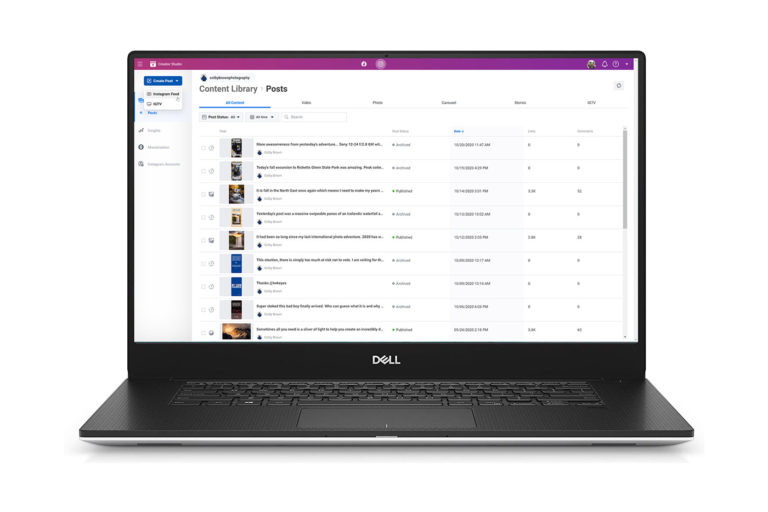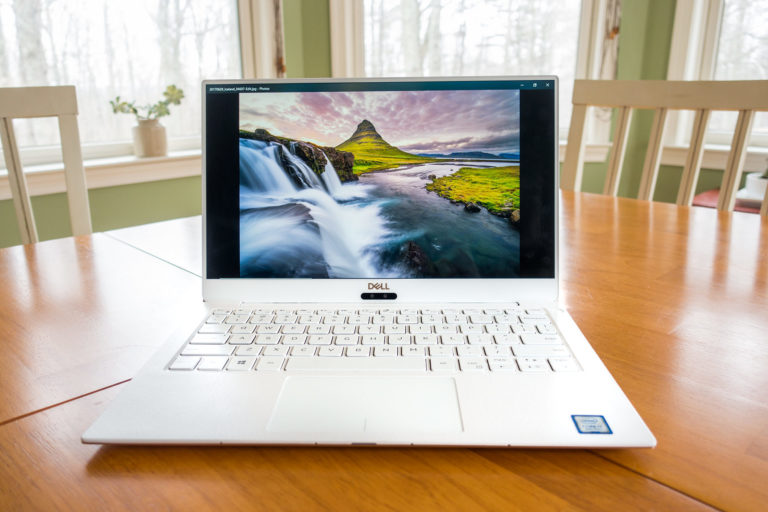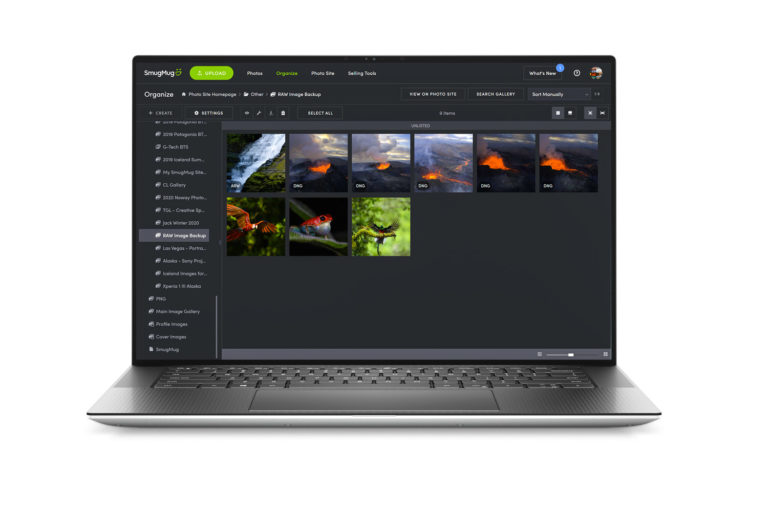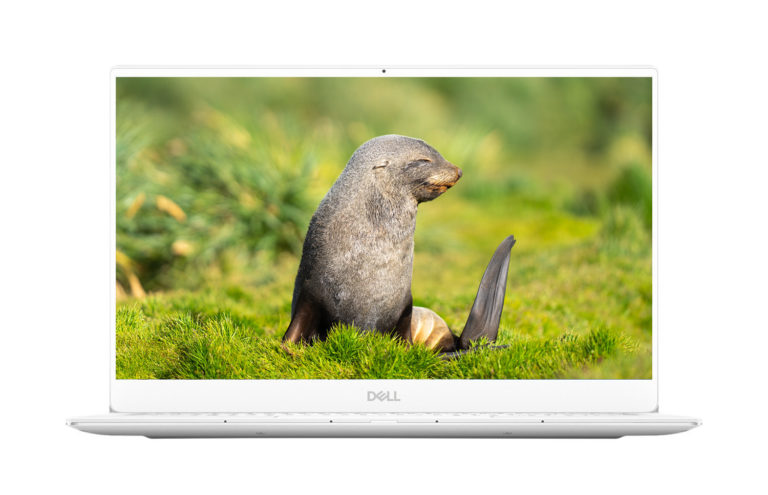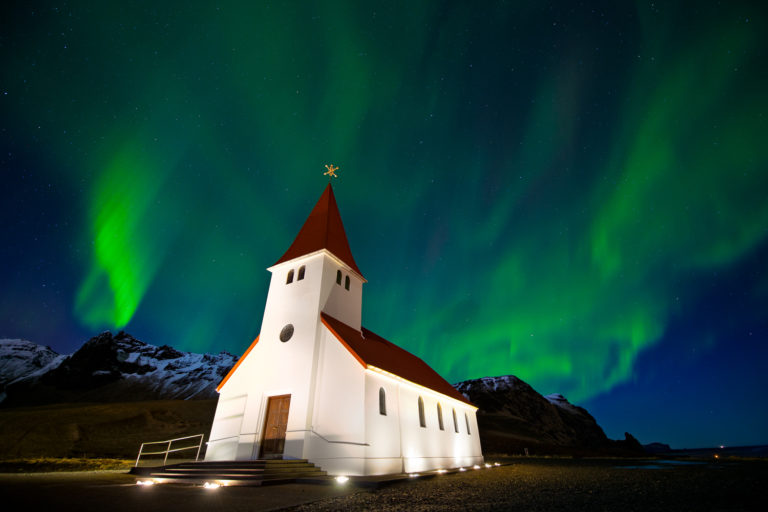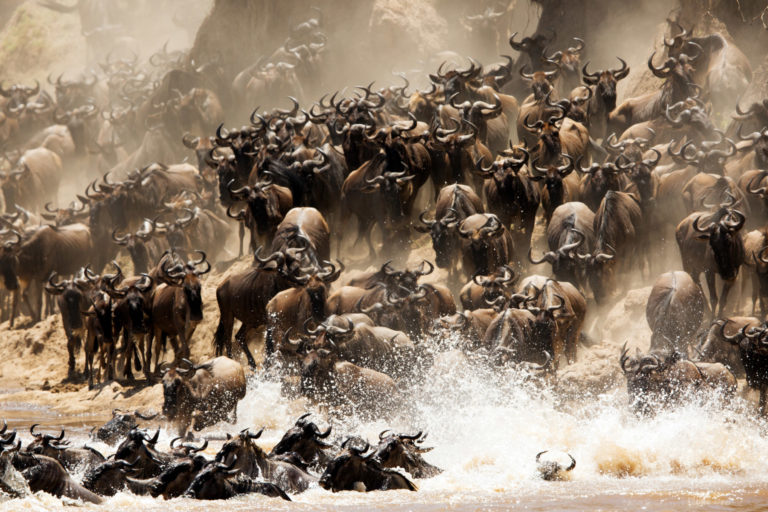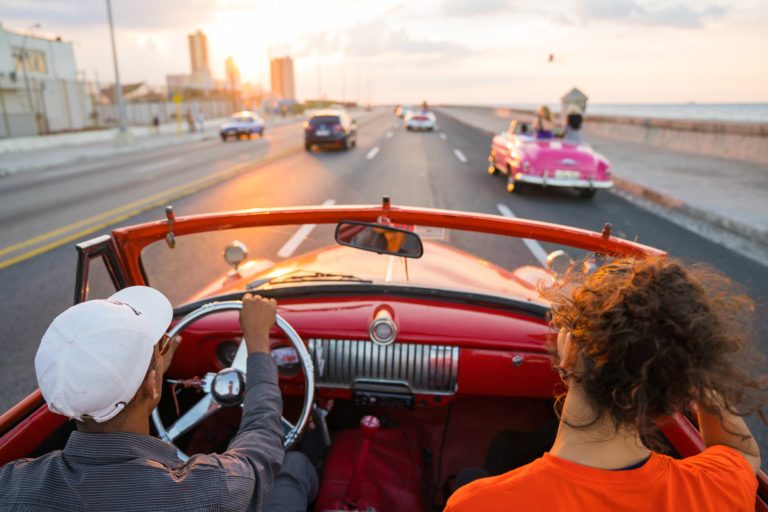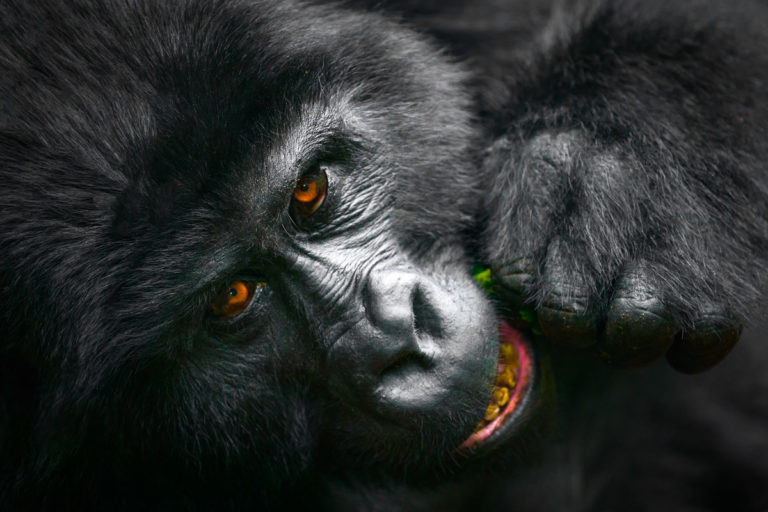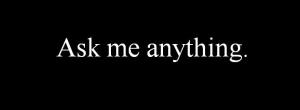 As many of you already know, I have been running multiple Photography AMA (Ask Me Anything) sessions on Facebook and Google+ over the last few months. These incredibly popular posts were opportunities for photographers from all over the globe to have direct access to me in order to get answers for any questions they might have that pertain to photography, the business of photography or travel. While I enjoyed having the opportunity to answer up to 200 questions in a single question, I found that many questions required more in-depth responses. It is for this reason that I am stoked to introduce my brand new blog series titled “Photographer AMA (Ask Me Anything)”.
As many of you already know, I have been running multiple Photography AMA (Ask Me Anything) sessions on Facebook and Google+ over the last few months. These incredibly popular posts were opportunities for photographers from all over the globe to have direct access to me in order to get answers for any questions they might have that pertain to photography, the business of photography or travel. While I enjoyed having the opportunity to answer up to 200 questions in a single question, I found that many questions required more in-depth responses. It is for this reason that I am stoked to introduce my brand new blog series titled “Photographer AMA (Ask Me Anything)”.
Each blog post in this series will have a specific focus, such as marketing your images, photo editing techniques or general travel as a photographer where I answer questions such as how do I handle getting visas in specific countries. Each question that I address will come directly from photographers like you from all over the globe. If you want to submit a question that you would like me to answer in a future Photographer AMA post, click HERE.
Today’s focus is on the use of Social Media for photographers. Lets begin…
“Have you ever been successful at selling prints through Social Media?” from Todd Sipes
Selling prints through social media channels has always been a funny thing. Why? Because when a photographer first joins a network, who does he/she look to connect with first? The photo community right? This means that for the average user, the base of their followers are actually other photographers rather than potential paying clients or customers outside the photo industry. If there is one thing that I have learned over the last 8 years of being a photog, it is that other photographers would rather see their own prints on their walls rather than one of mine. To understand this a bit more, lets dig a little deeper into the psychology of purchase art.
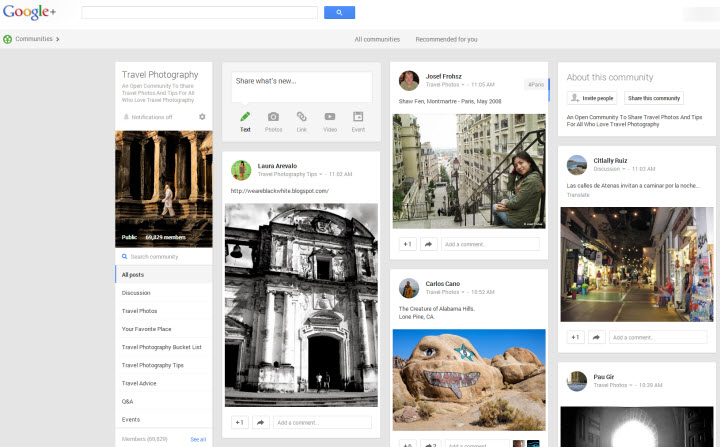
The act of selecting a piece of art to hang on ones wall is a very personal choice. Most people do not just display “pretty” things on their wall…but objects that have a personal meaning instead. This could be a statue that reminds them of a trip or a piece of art that embodies a specific feeling they want to be reminded of, such as strength. When it comes to photography, this is no different. One of the reasons that photographers would rather see their own work on their walls is that they have understandably established a personal connection to their work. However your average customer is not going to have these same established connections. Instead they will tend to purchase a print that has to do with their home state/providence, a photo of a family member or possibly one of your images that reminds them of one of their own adventures to a specific location, such as the shot of the ancient city of Petra below.

At the end of the day, you can use this information to more effectively and efficiently market yourself and your prints. How? Here are two examples…
- If your focus is on travel photography, than make sure that you not only share your images across multiple different platforms (Facebook, Google+, Flickr, 500px, Fine Art America), but also include all relevant text and information about an image. Don’t just post the photo, talk about the image or what it was like traveling to this location. Not only will this help your followers potentially establish a more intimate connection with your shot, but it will also give the search engines of these various social platforms more data to allow your image to be searchable. If you never use the word “Jordan” or “Petra” when you post a photo like the one above, no one will be able to find it if they are actively looking for images of this location.
- Location based advertising should be your best friend when it comes to marketing your prints or your brand. If you have many great images of Colorado in your portfolio, you should actively be advertising directly to active internet users in that state, whether that is for selling a specific photo or your entire portfolio of images that have to do with Colorado. Facebook ads, Google Adsense and even Twitter allow you to do location specific ads/marketing. For the social networks that don’t provide this functionality, make sure you include the GPS location on sites like Flickr and 500px as most social platforms are starting to do much more with locations based targeted searches.
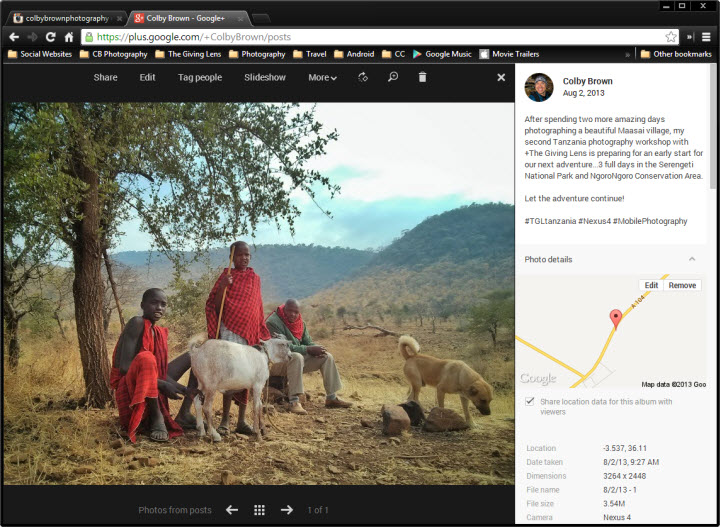
“How important is social media in regards to driving more traffic to our sites?” from Scotty Graham
When it comes to driving web traffic to your website, I would arguably say that social media is by far the most important weapon you have at your disposal as a photographer. Before social platforms became as popular as they are today, photographers, like any website owners, had to learn to complex nature of SEO or Search Engine Optimization. This involved learning all you could about Google, Bing and Yahoo’s latest search algorithms so that you could potentially include the best titles, page descriptions, tags and of course text to your website pages and blog posts in hopes that they would be found. This was a confusing and complex approach that left most photographers guessing.
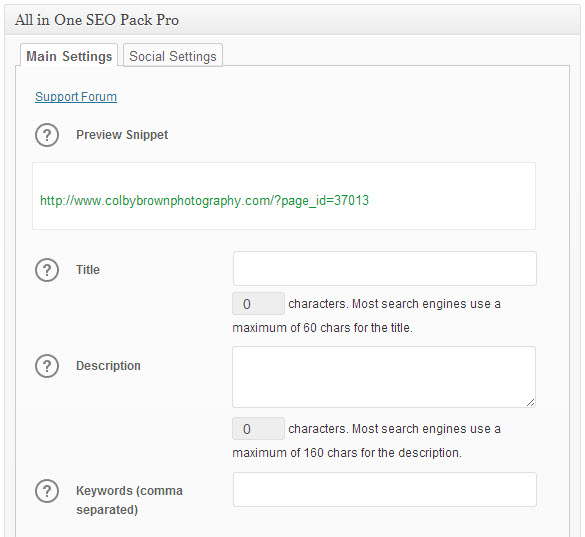
Luckily those days are over to some extent. While I still believe that you need to have solid content and provide an accurate page title and description in order to help your organic search results, social media has changed the game. When used correctly, you can utilize your various social channels to drive more traffic to your website than you ever thought was possible. How can you do this and what does “used correctly” actually mean? Let me talk about my own workflow as an example.
When I sat down a few years ago and begin to devise my own Social Media strategy, I adopted what I like to call the “Grand Central Station” philosophy. This places my website, or my Grand Central Station, at the center of my online digital world. After all this is where I actually sell my prints, my ebooks, show off my entire photo portfolio and have people sign up for my photography workshops. When it comes to the various social networking platforms that I utilize, they are like the satellite cities where my “train” of digital content flows. As I share content on these various social networks, I want users to not only consume that content on Facebook or Google+, but I also want to strategically direct people back to my online hub…my Grand Central Station…when it is appropriate.
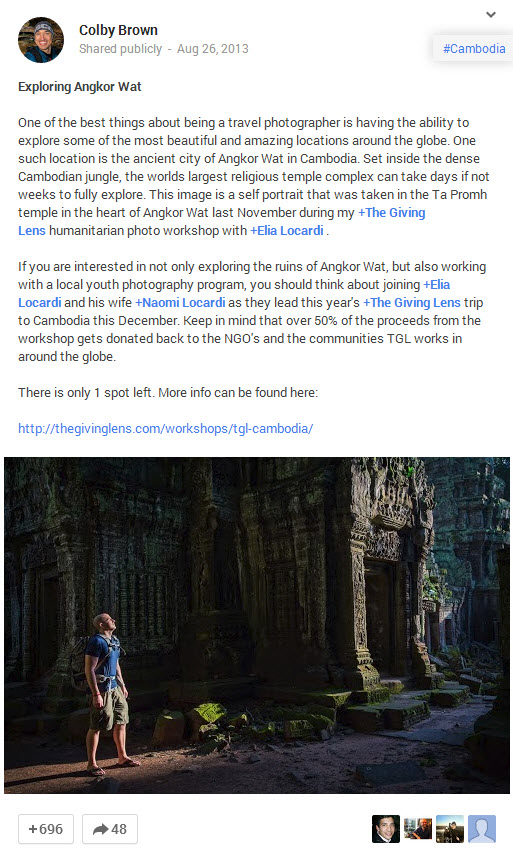
The phrase “when it is appropriate” is the key point here. As I have talked about before in my books about social media, no matter how beautiful, charming or talented you think you are, no one wants to listen to you talk about yourself 24 hours a day / 7 days a week. Social Networking is after-all about being “social”. It is about connecting and engaging with other individual that share your interests or passions, regardless if you are trying to make a living as a photographer or just looking for inspiration. This means that you need to find other things to talk about than just you. If you look at the most successful photographers on social media, 99% of them talk about a wide variety of subjects and most even work to lift up other artists as well. All of this provides exponentially more points of interaction between yourself and your users than if you only talked about how great your images are or just tried to sell your followers something with every post.

It is also important to think about how content is viewed on various social networks as well. For example, if you publish a photo directly to Facebook or Google +, you will generally receive much more interaction on your post than if you just shared a hyperlink from your website and provided a some text. Why is this? Because most social networks want you to stay ON their social networks and not venture to too many other social platforms. This means that you have to be selective when it comes to how you decide to share content online. There are times when I will directly share a link on Google +, but the majority of time I will simply post an Image directly to a social network, such as an image of Iceland, and than provide context and a hyperlink back to one of my e-books if that is what I am looking to market.
“How do we go about getting more interest/followers/likes on your social media pages?” from Jacqui H
Unfortunately this question is not very easy to answer. Too many people are simply looking for a short cut or universal solution when it comes to finding social media success. They miss the point of social media in the first place, which is about being “social”. Like most things in business, it takes time to build a quality following and spur engagement with the content you publish. You have to think of it more as an investment, than a short cut to “making it” as a photographer.

The reality is that depending on what your goals for being on social networks to begin with, the solutions on how to grow a brand or a following can be different. For example, if you are a wedding photographer that is looking to gain more followers and secure more clients, your approach will need to be different from a Fine Art Photographer that is hoping to sell some prints. In order to get started in the right direction, you need to develop a Social Media Strategy based around your needs and goals. A common misconception when it comes to social media is the fact that you have to be on every social network as a photographer. Who has time for that? Let alone that fact that certain social channels are typically better for certain types of photographers. Are you a wedding or event photographer looking to score more clients? Than you should most likely concentrate your time on both Facebook and Pinterest. Are you a Fine Art Photographer looking to sell prints? Flickr, 500px and Fine Art America are probably three of your best bets. This doesn’t mean that you can’t or shouldn’t be on Google+ if you enjoy the photo community there or be active on Facebook to try to sell prints…it is simply that certain kinds of photographers tend to do better on certain social networks than others.
Now to wrap back around to the initial question, my best piece of advice for those wanting to build a following and increase interaction is to engage yourself. Too often I see photographers complain about having low interaction rates or a small number of followers while they hardly ever interact with other people on social networks. To get engagement, you have to engage with others yourself. Chime in on others posts, follow people you are interested in and don’t forget to return to your posts to interact and engage with people that have chosen to engage with you. I am always blown away when people are surprised that I happily respond to their comments on my posts. Isn’t that the point of social media…to connect and engage with others?

“While photo educators, wedding and event photographers seem to benefit from the use of Social Media, what about photo journalists, commercial photographers and fine art photographers?” from Isaiah Brookshire
This is a great question and one that comes up often when I talk about Social Media from a photographers perspective. As a photo educator, I tend to find myself on nearly every social network as that is where my potential clients are. While some networks are better than others, I can generally find good use of nearly every major digital social platform out there. This however is not the norm for most photographers out there trying to make a living or even those simply wanting to supplement their passion for the art form. As I talked about in a previous question, you really need to define why you want to be on social media from the start. Do you want to sell prints? Are you looking for inspiration? What about education? Networking? The reality is that every photographer can find positive use of social media if you not only know where to look…but what you are looking for.
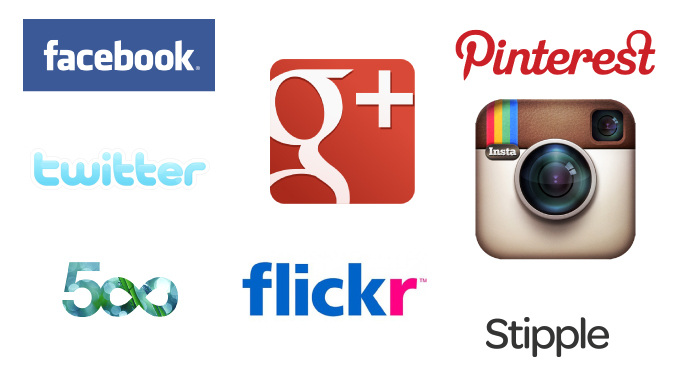
As for photo journalists, commercial photographers and fine art photographers, social media can still play an active role in your business model. Photo Journalists want to share their stories and publications with other users, effectively increasing their view rates and making their clients happy. If you help to facilitate one of your articles going viral, I promise you your employer will not be upset with you. If you are into commercial photography, you could use a platform such as Flickr to not only elevate your standing within the photo industry, but also potentially pick up new clients and maybe licence some of your non exclusive images through their connection with Getty. If you are a Fine Art Photographer looking to sell your prints, the more places you can display your images online, the better. You never know where a potential buyer might come from. Even online art showcases such as Fine Art America have many social platform interactions built into your images displayed on their website, such as tweeting an image or “like”ing it on Facebook. Those interactions hold value in spreading the word about your work.
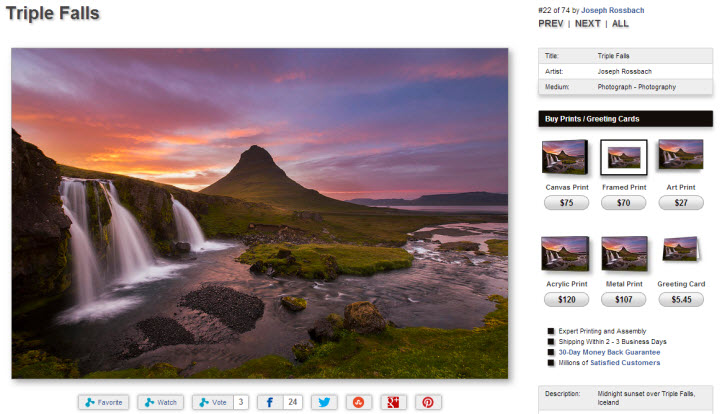
“Is tagging people/ places a good idea to get more exposure and build connections? or what is a good way to make good connections ?” from Scott Fisher
When it comes to tagging people and places, I am split on my thoughts. As a photographer that has built up a large following across most social networks, I get tagged by other users vying for my attention way more than is normally tolerable. This has caused me to have a negative connotation towards “tagging” individuals in a post when they have no direct involvement in an image. Tagging locations or businesses on the other hand can actually be fairly positive in its potential benefits for a photographer. Nearly every marketing campaign I work on with my clients or sponsors involves a required element to tag their respective social media pages in every post, allowing other users to have the ability to follow these companies as well.
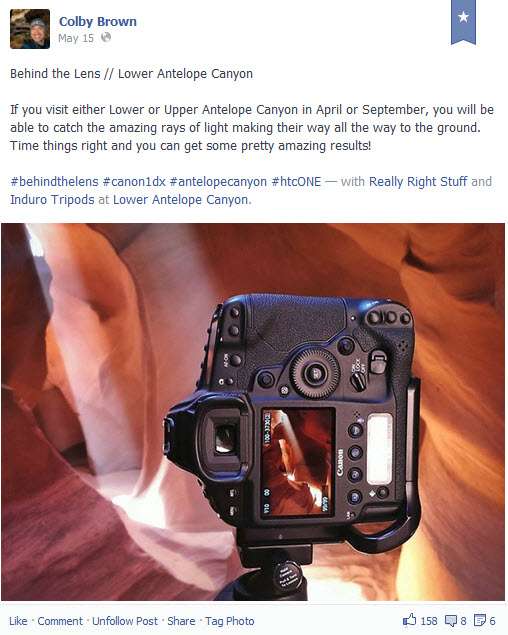
While this approach is a bit taboo for an individual looking to score a contract with a company, it can help put you on the radar of a company if you are looking for some form of sponsorship. It is important to know however that nearly every major brand (and most large companies) don’t handle their own social media pages. This is generally done by a marketing firm that represents the brand instead. Nike, Subaru, Nokia, Sony….all of these companies social media pages are handled by outside companies that specialize in online marketing and social media. This doesn’t mean that connecting with the people running these pages can’t still provide a foot in the door with the company you are going after. But it is good to know that most of the time, you wont be speaking to an actual employee of Nike or Sony regardless if they respond to your tags on Instagram or Facebook.
When it comes to the BEST way to make connections with other professionals or business you hope to do business with, my favorite social network is by far LinkedIn. I have scored more marketing campaigns, made more in-roads and found more partnerships with companies via LinkedIn than any other social network…hands down. While many photographers balk at the idea of being active on LinkedIn, it is simply being done out of ignorance and a lack of education on the merits of the professional social platform. Fill out your profile, update your resume and begin to look for connections in the companies you are interested in working with. If you are looking for sponsorship, try to connect with someone in the marketing or PR (public relations) departments of the company you are interested in.
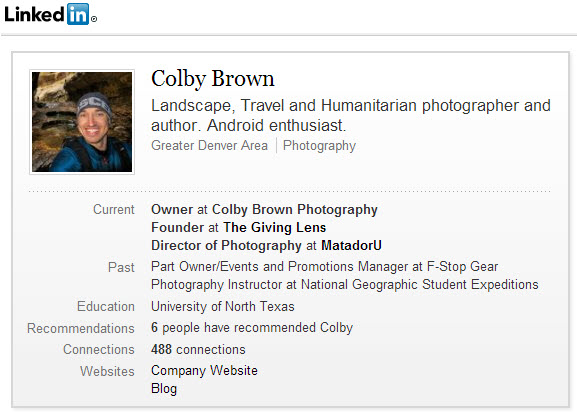
“What’s the best approach for photographers trying to get their work/reputation established on Facebook? A separate page? A separate profile from their personal profile? Or manage it all in one place?” from Mike Chambers
This question has been debated for as long as Facebook has allowed users to create their own fan or business pages. If you look at my presence on Facebook, you can see that I only have a personal profile titled Colby Brown. I used to have a business page for Colby Brown Photography, but I found operating two entities on Facebook required more time that I was willing to invest into the social network. In fact, you will only ever see me have one page/profile on every social network. The reason that this works for me is, two fold:
- My name is built into my main photography company’s name, Colby Brown Photography. This gives me a bit of leeway in using my own personal profile to promote my work as a photographer.
- I have worked hard over the years to establish my brand as neither one of my photography companies, Colby Brown Photography or The Giving Lens, but of just Colby Brown. Users of various social platforms choose to follow me for a multitude of reasons, which sometimes don’t’ have anything to do with photography, the workshops I offer or the prints I sell. In essence, my brand involves all of my interests…not just those tied to my businesses.
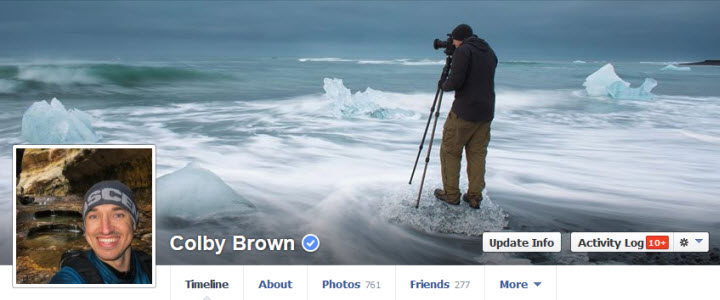
If you are trying to build a new shipping company, you wouldn’t just try to promote it solely via your personal page on Facebook would you? No, you would create a separate business page in order to establish itself out on its own. On FB, this means that you also have the ability to have multiple admins, meaning that employees could help you run your business page. With my humanitarian focused photography company, The Giving Lens, we have a business page for just that reason. Any of my employees (that I give access to) can help me run the page, allowing me to concentrate on other more pressing issues with the company itself.
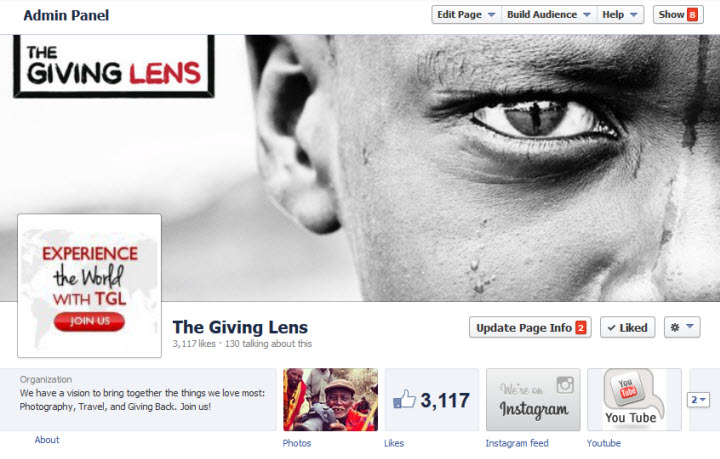
With a Facebook business/fan page, you also have the ability to have access to what Facebook calls “Insights”. This is statistical data that can be incredibly helpful when trying to determine the effectiveness of a marketing campaign or if you want to learn more information about your followers. This is unfortunately a feature that Facebook doesn’t provide to users with personal profiles, but I am hoping that will change in the future.

Bringing things back to the initial question, I think it comes down to how you want to brand your company. Does the name of your company matter in the long run? Is your name part of your company name? How valuable do you find statistical data when it comes to helping you determine your best approach for Facebook? By answering these questions, the answer should present itself to you on its own. For me…I enjoy not having a business page for Colby Brown Photography. Do I miss the page “Insights” feature…absolutely…but I am holding my breath for the point in time that this information is given to ALL Facebook users.
To find out more about Social Media…
If your question was not answered or you are simply looking for more information about utilizing Social Media as a photographer, you can check out my other blog posts that focus on Social Media, purchase my book “Google+ for Photographers” or even check out Kelby Training Live near the end of 2013 when my latest online social media class goes live. You are also free to leave a comment below if you have further questions or something else to add to this post.
Photographer AMA Submission Form
If you are interested in submitting a question that you would like for me to answer in a future “Photographer AMA (Ask Me Anything)” blog post, please follow this LINK to my online submission form and fill out the necessary fields.

